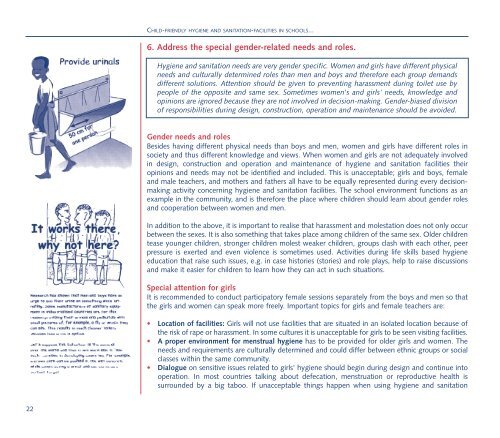Child-Friendly Hygiene and Sanitation Facilities in Schools
Child-Friendly Hygiene and Sanitation Facilities in Schools
Child-Friendly Hygiene and Sanitation Facilities in Schools
You also want an ePaper? Increase the reach of your titles
YUMPU automatically turns print PDFs into web optimized ePapers that Google loves.
CHILD-FRIENDLY HYGIENE AND SANITATION-FACILITIES IN SCHOOLS...<br />
6. Address the special gender-related needs <strong>and</strong> roles.<br />
<strong>Hygiene</strong> <strong>and</strong> sanitation needs are very gender specific. Women <strong>and</strong> girls have different physical<br />
needs <strong>and</strong> culturally determ<strong>in</strong>ed roles than men <strong>and</strong> boys <strong>and</strong> therefore each group dem<strong>and</strong>s<br />
different solutions. Attention should be given to prevent<strong>in</strong>g harassment dur<strong>in</strong>g toilet use by<br />
people of the opposite <strong>and</strong> same sex. Sometimes women's <strong>and</strong> girls' needs, knowledge <strong>and</strong><br />
op<strong>in</strong>ions are ignored because they are not <strong>in</strong>volved <strong>in</strong> decision-mak<strong>in</strong>g. Gender-biased division<br />
of responsibilities dur<strong>in</strong>g design, construction, operation <strong>and</strong> ma<strong>in</strong>tenance should be avoided.<br />
Gender needs <strong>and</strong> roles<br />
Besides hav<strong>in</strong>g different physical needs than boys <strong>and</strong> men, women <strong>and</strong> girls have different roles <strong>in</strong><br />
society <strong>and</strong> thus different knowledge <strong>and</strong> views. When women <strong>and</strong> girls are not adequately <strong>in</strong>volved<br />
<strong>in</strong> design, construction <strong>and</strong> operation <strong>and</strong> ma<strong>in</strong>tenance of hygiene <strong>and</strong> sanitation facilities their<br />
op<strong>in</strong>ions <strong>and</strong> needs may not be identified <strong>and</strong> <strong>in</strong>cluded. This is unacceptable; girls <strong>and</strong> boys, female<br />
<strong>and</strong> male teachers, <strong>and</strong> mothers <strong>and</strong> fathers all have to be equally represented dur<strong>in</strong>g every decisionmak<strong>in</strong>g<br />
activity concern<strong>in</strong>g hygiene <strong>and</strong> sanitation facilities. The school environment functions as an<br />
example <strong>in</strong> the community, <strong>and</strong> is therefore the place where children should learn about gender roles<br />
<strong>and</strong> cooperation between women <strong>and</strong> men.<br />
In addition to the above, it is important to realise that harassment <strong>and</strong> molestation does not only occur<br />
between the sexes. It is also someth<strong>in</strong>g that takes place among children of the same sex. Older children<br />
tease younger children, stronger children molest weaker children, groups clash with each other, peer<br />
pressure is exerted <strong>and</strong> even violence is sometimes used. Activities dur<strong>in</strong>g life skills based hygiene<br />
education that raise such issues, e.g. <strong>in</strong> case histories (stories) <strong>and</strong> role plays, help to raise discussions<br />
<strong>and</strong> make it easier for children to learn how they can act <strong>in</strong> such situations.<br />
Special attention for girls<br />
It is recommended to conduct participatory female sessions separately from the boys <strong>and</strong> men so that<br />
the girls <strong>and</strong> women can speak more freely. Important topics for girls <strong>and</strong> female teachers are:<br />
• Location of facilities: Girls will not use facilities that are situated <strong>in</strong> an isolated location because of<br />
the risk of rape or harassment. In some cultures it is unacceptable for girls to be seen visit<strong>in</strong>g facilities.<br />
• A proper environment for menstrual hygiene has to be provided for older girls <strong>and</strong> women. The<br />
needs <strong>and</strong> requirements are culturally determ<strong>in</strong>ed <strong>and</strong> could differ between ethnic groups or social<br />
classes with<strong>in</strong> the same community.<br />
• Dialogue on sensitive issues related to girls' hygiene should beg<strong>in</strong> dur<strong>in</strong>g design <strong>and</strong> cont<strong>in</strong>ue <strong>in</strong>to<br />
operation. In most countries talk<strong>in</strong>g about defecation, menstruation or reproductive health is<br />
surrounded by a big taboo. If unacceptable th<strong>in</strong>gs happen when us<strong>in</strong>g hygiene <strong>and</strong> sanitation<br />
22

















